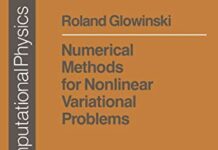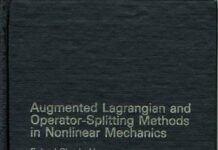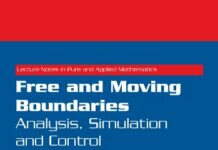
Ebook Info
- Published: 2003
- Number of pages: 1080 pages
- Format: PDF
- File Size: 13.80 MB
- Authors: Roland Glowinski
Description
This book-size article is dedicated to the numerical simulation of unsteady incompressible viscous flow modelled by the Navier-Stokes equations, or by non-Newtonian variants of them. In order to achieve this goal a methodology has been developed based on four key tools. Time discretization by operator-splitting schemes such as Peaceman-Rachford’s, Douglas Rachford’s, Marchuk-Yanenko’s, Strang’s symmetrized, and the so-called theta-scheme introduced by the author in the mid-1980s. Projection methods (in L2 or H1) for the treatment of the incompressibility condition div u = 0. Treatment of the advection by: either a centered scheme leading to linear or nonlinear advection-diffusion problems solved by least squares/conjugate gradient algorithms, or to a linear wave-like equation well suited to finite element-based solution methods. Space approximation by finite element methods such as Hood-Taylor and Bercovier-Pironneau, which are relatively easy to implement. conjugate gradient algorithms, least-squares methods for boundary-value problems which are not equivalent to problems of the calculus of variations, Uzawa-type algorithms for the solution of saddle-point problems, embedding/fictitious domain methods for the solution of elliptic and parabolic problems. In fact many computational methods discussed in this article also apply to non-CFD problems although they were mostly designed for the solution of flow problems. Among the topics covered are: the direct numerical simulation of particulate flow; computational methods for flow control; splitting methods for viso-plastic flow a la Bingham; and more. It should also be mentioned that most methods discussed in this article are illustrated by the results of numerical experiments, including the simulation of three-dimensional flow. easy to implement – as is demonstrated by the fact that several practitioners in various institutions have been able to use them ab initio for the solution of complicated flow (and other) problems.
User’s Reviews
Editorial Reviews: Review 1998 …A clear and detailed overview of the concepts, methods and problems encountered using numerical path following. — Newsletter on Computational and Applied Mathematics1998 …A clear and detailed overview of the concepts, methods and problems encountered using numerical path following. — Newsletter on Computational and Applied Mathematics2000 …..this is an immensely thorough text, densely filled…. — Ultramiscroscopy, Vol. 802000 …..this is an immensely thorough text, densely filled…. — Ultramiscroscopy, Vol. 80June 2000 …..the volume would be a delight to the mathematically-oriented readers……. — Karmeshu and S Balasundaram, Jnl of Scientific and Industrial Research, Vol. 59June 2000 …..the volume would be a delight to the mathematically-oriented readers……. — Karmeshu and S Balasundaram, Jnl of Scientific and Industrial Research, Vol. 59
Reviews from Amazon users which were colected at the time this book was published on the website:
⭐Please give this book to your students–they will learn this topic the right way, how to implement, and what good writing looks like.
⭐
Keywords
Free Download Handbook of Numerical Analysis : Numerical Methods for Fluids (Part 3) in PDF format
Handbook of Numerical Analysis : Numerical Methods for Fluids (Part 3) PDF Free Download
Download Handbook of Numerical Analysis : Numerical Methods for Fluids (Part 3) 2003 PDF Free
Handbook of Numerical Analysis : Numerical Methods for Fluids (Part 3) 2003 PDF Free Download
Download Handbook of Numerical Analysis : Numerical Methods for Fluids (Part 3) PDF
Free Download Ebook Handbook of Numerical Analysis : Numerical Methods for Fluids (Part 3)


